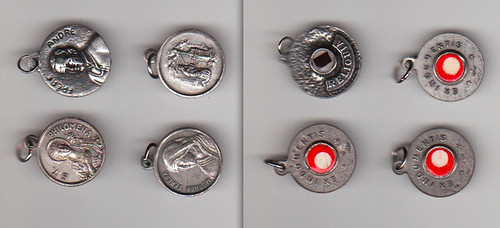Pilgrim Badges in a Medieval Book of Hours
"But perhaps the commonest medieval amulet of all was the pilgrim badge, made of tin-lead alloy, or poor-quality pewter. These badges were sacralized by being touched to a relic or shrine of the saint commemorated [...] Pilgrim badges might be obtained specifically to fulfill their role as amulets. Th French King Charles V, whose health was always delicate, obtained three enseignes 'for the disease of the kidneys,' as recorded in 1379-80. Sometimes they were used not just on the individual's body but to protect other people, places, or animals."
-- from Visualizing Medieval Medicine and Natural History, 1200-1550, Jean Ann Givens

Pilgrim's Badge Depicting the Shrine of Saint Thomas Becket at Canterbury Cathedral, 1350–1400
"Although pilgrim badges might look insignificant in comparison to other works of art, they are a valuable source of information for medieval iconograhy, because as these miniature images were produced, purchased, and dispersed in substantial numbers, they actively participated in the spread of visual language."
-- from "Medival Pilgrim Badges and Their Iconographic Aspects", Marike de Kroon

Erotic Pilgrim Badge
"The importance of these badge finds can scarcely be exaggerated; in addition to Bedaux, other scholar have also concluded that the profane badges, no matter what their imagery, were devices intended to avert bad luck, and by corollary, bring good luck. Those designed with sexual imagery represent a remarkably high percentage in the assemblage of profane secular badges. Dating mostly from the late 14th into the fifteenth centuries, they often contain images of, or are designed as, male or female sexual organs, or as combinations of male and female; sometimes they are devised as copulation scenes, and there are related variations. [...]If any doubt lingers about the apotropaic significance of sexual symbols, I point to some medieval amulets, dated in the fifteenth century, which eminently demonstrate what powerful protection most people believed-- at least in the fifteenth century-- sexual symbols to possess [...] They clearly declare the principle that the more talismans you ave, the more protect you will have; and they also manifest a significant cohabitation of apotropaic Christian and non-Christian motifs."
-- from Averting Demons: The Protecting Power of Medieval Visual Motifs and Themes, Ruth Mellinkoff

Contemporary Pilgrim Badges, My Collection

